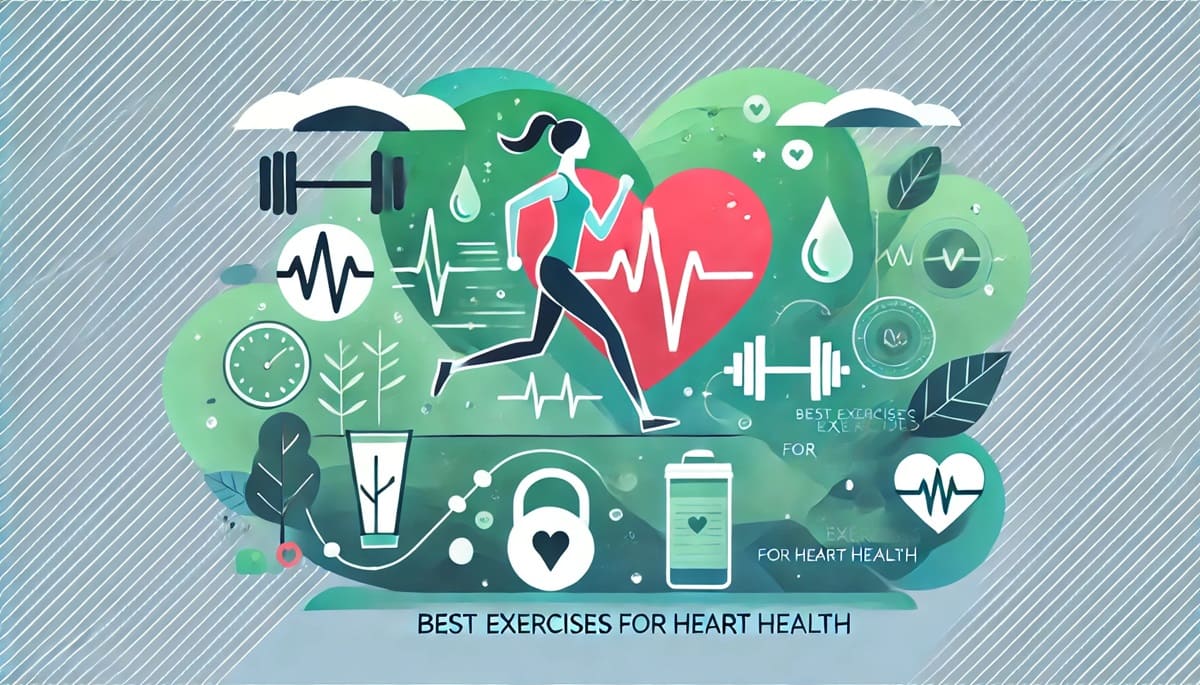
Best Exercises for Heart Health
Maintaining a healthy heart is crucial for overall well-being. Regular physical activity is one of the best ways to improve cardiovascular health, reduce the risk of heart disease, and maintain a strong circulatory system. In this blog, we will explore some of the best exercises that promote heart health and how to incorporate them into your daily routine.
Table of Contents
ToggleWhy Exercise Is Important for Heart Health
Exercise strengthens the heart, just as it does with any other muscle in the body. The heart pumps blood more efficiently when it is in good shape, reducing strain on the cardiovascular system. Regular exercise also helps lower blood pressure, reduce cholesterol levels, improve circulation, and manage body weight—key factors in preventing heart disease.
Benefits of exercise for the heart:
- Strengthens the heart muscle: Exercise makes your heart stronger, allowing it to pump more blood with less effort.
- Lowers blood pressure: Regular physical activity helps regulate blood pressure, reducing the risk of hypertension.
- Improves cholesterol levels: Exercise helps increase HDL (good) cholesterol while lowering LDL (bad) cholesterol, which is important for preventing plaque buildup in arteries.
- Supports weight management: Maintaining a healthy weight through exercise reduces strain on the heart and lowers the risk of obesity-related heart conditions.
Incorporating heart-healthy exercises into your lifestyle can significantly reduce the risk of cardiovascular disease and promote long-term health.
Aerobic Exercise: The Foundation of Heart Health
Aerobic exercise, also known as cardiovascular exercise, is one of the most effective ways to boost heart health. These activities increase your heart rate and improve the body’s ability to use oxygen efficiently. Over time, aerobic exercise strengthens the heart and lungs, making it easier for the heart to pump blood throughout the body.
Examples of aerobic exercises:
- Walking: One of the simplest and most accessible exercises, walking is a great way to get your heart pumping without putting too much strain on your joints. Aim for 30 minutes of brisk walking most days of the week.
- Running or jogging: For those who want to take their cardiovascular workout to the next level, running or jogging offers a higher intensity option that strengthens the heart even more.
- Swimming: A full-body workout that is easy on the joints, swimming is an excellent choice for improving heart health and building endurance.
- Cycling: Whether you’re riding a stationary bike or cycling outdoors, this low-impact exercise helps strengthen the heart while improving leg strength.
To get the most benefit from aerobic exercises, aim for at least 150 minutes of moderate-intensity activity or 75 minutes of vigorous-intensity activity each week.
Strength Training: Building a Stronger Heart
Strength training, also known as resistance training, is another important component of heart health. While many people associate strength training with building muscle, it also offers cardiovascular benefits. Strength training helps reduce body fat, increase lean muscle mass, and improve metabolism—all of which support heart health.
Strength training exercises for heart health:
- Weightlifting: Lifting weights or using resistance bands can help build muscle and improve cardiovascular health. Start with lighter weights and gradually increase the resistance as your strength improves.
- Bodyweight exercises: Push-ups, squats, and lunges are examples of bodyweight exercises that target multiple muscle groups while enhancing heart health.
- Pilates: This low-impact exercise focuses on core strength, flexibility, and posture, while also improving circulation and supporting heart health.
For optimal results, aim to include strength training exercises at least two days per week in addition to your aerobic workouts.
High-Intensity Interval Training (HIIT) for a Healthy Heart
High-Intensity Interval Training (HIIT) is a popular workout method that alternates between short bursts of intense activity and periods of rest or lower-intensity exercise. HIIT workouts are highly effective at improving cardiovascular fitness in a short amount of time, making them a great option for busy individuals.
Benefits of HIIT for heart health:
- Improves cardiovascular endurance: HIIT increases your heart rate quickly, which helps build endurance and strengthen the heart.
- Burns calories efficiently: HIIT workouts are known for their ability to burn a high number of calories in a short period, promoting weight loss and supporting heart health.
- Enhances oxygen consumption: Regular HIIT workouts improve your body’s ability to consume and use oxygen, which is important for cardiovascular fitness.
An example of a HIIT workout might include 30 seconds of sprinting followed by 1 minute of walking, repeated for 15–20 minutes. HIIT can be adapted to various exercises such as cycling, swimming, or jumping rope.
Yoga and Flexibility Training: Relaxation for the Heart
Yoga and other flexibility exercises may not seem as intense as aerobic or strength training, but they offer unique heart health benefits. Yoga combines physical postures with controlled breathing and meditation, which helps reduce stress and lower blood pressure—both important factors for heart health.
How yoga supports heart health:
- Reduces stress and anxiety: Stress is a significant risk factor for heart disease, and yoga is an effective way to manage stress by promoting relaxation and mindfulness.
- Lowers blood pressure: Regular yoga practice has been shown to lower blood pressure, reducing the risk of heart disease.
- Improves circulation: Certain yoga poses promote blood flow, supporting a healthy cardiovascular system.
Incorporating yoga or other flexibility exercises into your routine a few times a week can help you relax, improve flexibility, and support your heart.
The Role of Consistency in Heart Health
While it’s important to incorporate various types of exercise into your routine, consistency is key. The heart benefits most from regular, sustained physical activity. Whether you prefer walking, swimming, or strength training, the most important factor is maintaining a routine that keeps you active.
Tips for staying consistent:
- Set realistic goals: Start with achievable goals, such as walking for 20 minutes a day, and gradually increase the intensity or duration of your workouts.
- Find activities you enjoy: Choose exercises that you find enjoyable so that you’re more likely to stick with them. Whether it’s dancing, cycling, or hiking, the key is to stay active.
- Stay motivated: Tracking your progress, joining a fitness class, or working out with a friend can help you stay motivated and consistent with your heart-healthy exercise routine.
By maintaining a consistent exercise routine, you’ll reap the long-term benefits of improved cardiovascular health, reduced risk of heart disease, and enhanced overall well-being.
Conclusion: Protecting Your Heart Through Exercise
Regular physical activity is one of the most powerful ways to protect your heart and promote a healthy lifestyle. From aerobic exercises to strength training and yoga, each type of exercise offers unique benefits that support cardiovascular health. By incorporating these activities into your routine and staying consistent, you can significantly reduce the risk of heart disease and improve your overall quality of life. Take the first step today toward a healthier, stronger heart!


